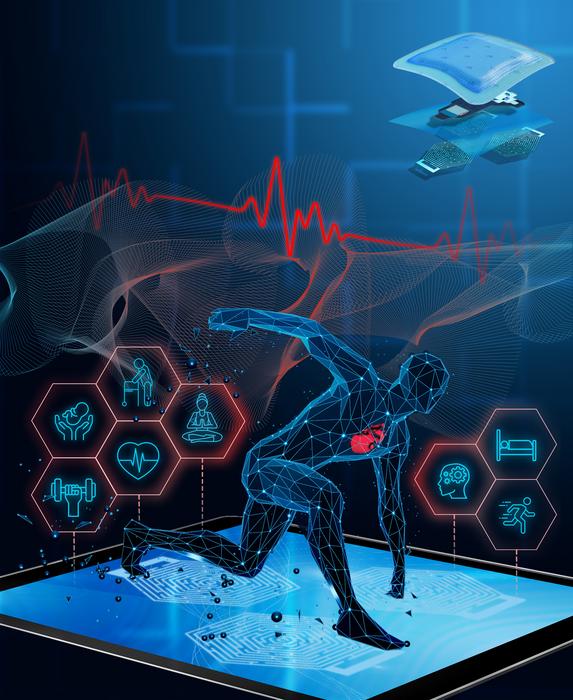WASHINGTON, Oct. 31, 2023 – Nearly 200 million people around the globe have coronary heart disease, which accounts for about one in every six deaths, according to the British Heart Foundation. That’s why the recent and rapid rise in wearable electronic health-monitoring devices with heart rate-measuring electrocardiograms (ECG) represents a significant step forward. By detecting cardiovascular ailments and helping assess overall cardiac health, wearable ECGs save lives, not to mention exorbitant hospital care costs.

Credit: Peter Francis Mathew Elango
WASHINGTON, Oct. 31, 2023 – Nearly 200 million people around the globe have coronary heart disease, which accounts for about one in every six deaths, according to the British Heart Foundation. That’s why the recent and rapid rise in wearable electronic health-monitoring devices with heart rate-measuring electrocardiograms (ECG) represents a significant step forward. By detecting cardiovascular ailments and helping assess overall cardiac health, wearable ECGs save lives, not to mention exorbitant hospital care costs.
In Applied Physics Reviews, by AIP Publishing, a group of researchers from Australia and India advanced the positive momentum with a study that presents a novel wearable ECG patch for enhanced point-of-care diagnostics.
“We did a deep dive into the world of wearable ECG devices,” said author Peter Francis Mathew Elango. “We focused on a critical aspect, how the design and materials of the electrodes impact their performance, and the findings were quite illuminating.”
Typically, Ag/AgCl electrodes, also known as “wet” electrodes, are used in devices to measure ECG signals and include a conductive gel to enhance electrical signaling. But these are known to be uncomfortable, irritating to the skin, and prone to drying out.
Instead, the study focused on the advantages of using active dry electrodes for ECG signaling and ultimately demonstrated an effective and promising prototype.
“Dry electrodes offer some significant advantages,” said Elango. “They prioritize user comfort, remain durable over time, and reduce the likelihood of skin irritation. These attributes make them ideal for continuous monitoring, a crucial feature for wearable ECG devices.”
The research included considerations of how the performance of dry electrode sensors is affected by the contact area, conductivity, and stability of the electrical contact. The team investigated various tight space geometry-based dry electrodes and different electrode geometries, studying their various influences on ECG sensing. They also examined how different body parts influence ECG measurements.
After extensive experimentation, they created a compact, lightweight, gel-free hexagonal-shaped ECG patch ideally suited for point-of-care diagnostics. The configuration was then integrated with wireless Bluetooth communication for remote sensing capabilities.
“The potential applications are where it gets really exciting,” said Elango. “These portable ECG patches could revolutionize remote and ambulatory healthcare, and perhaps even preventive medicine. They’re light, they can wirelessly transmit data, and they’re adept at discerning various states of rest or activity. Whether used in a clinical setting, seamlessly integrated into everyday attire, or worn as wearable devices, they could redefine how we monitor cardiac health.”
###
The article “Dry electrode geometry optimisation for wearable ECG devices” is authored by Peter Francis Mathew Elango, Shanmuga Sundar Dhanabalan, Md Rokunuzzaman Robel, Sherly Pushpam Elango, Sumeet Walia, Sharath Sriram, and Madhu Bhaskaran. The article will appear in Applied Physics Reviews on Oct. 31, 2023 (DOI: 10.1063/5.0152554). After that date, it can be accessed at http://aip.scitation.org/doi/full/10.1063/5.0152554.
ABOUT THE JOURNAL
Applied Physics Reviews features articles on significant and current topics in experimental or theoretical research in applied physics, or in applications of physics to other branches of science and engineering. The journal publishes both original research on pioneering studies of broad interest to the applied physics community, and reviews on established or emerging areas of applied physics. See https://pubs.aip.org/aip/apr.
###
Journal
Applied Physics Reviews
DOI
10.1063/5.0152554
Article Title
Dry electrode geometry optimisation for wearable ECG devices
Article Publication Date
31-Oct-2023




